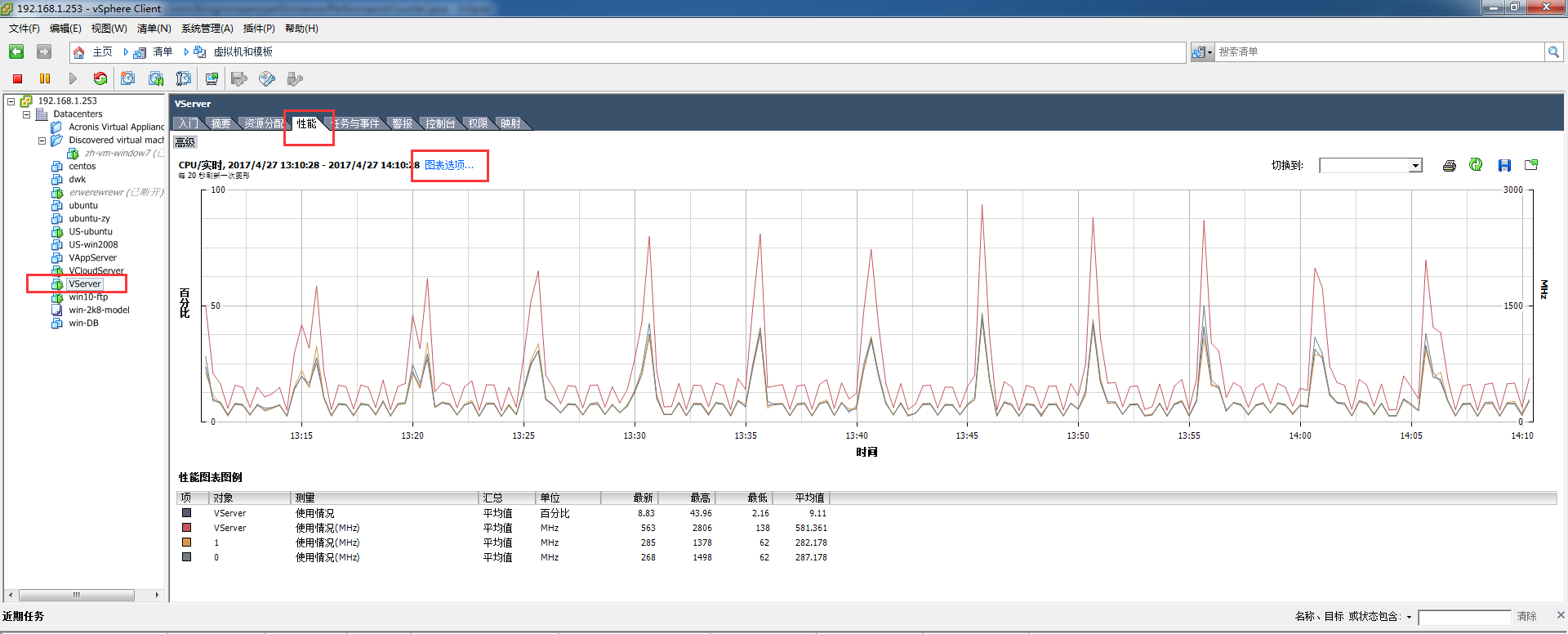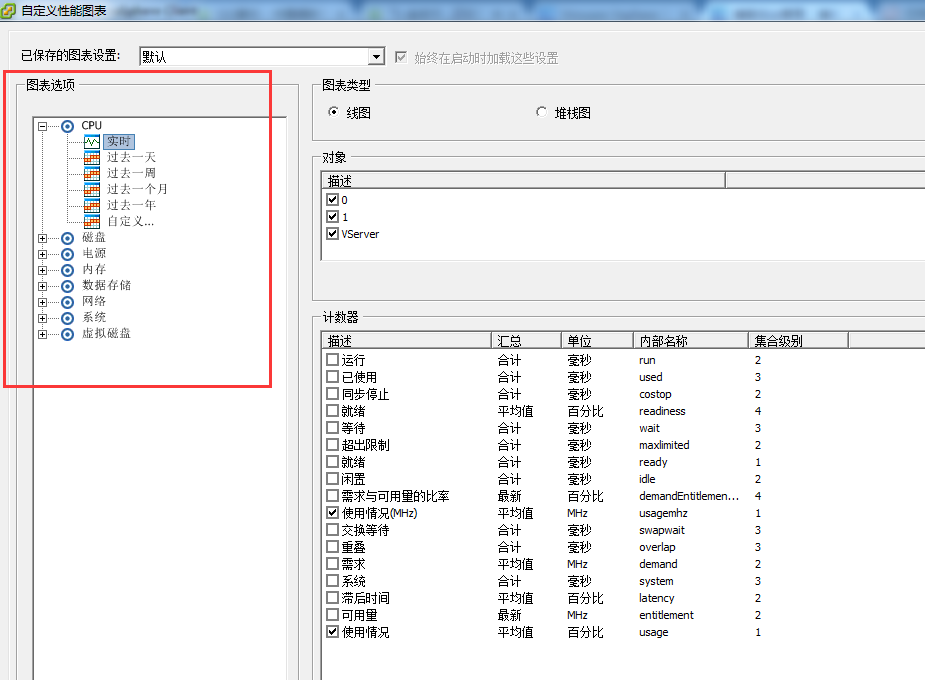Vmware Vsphere WebService之vijava 开发(二)一性能信息的采集(实时监控)
最近一直没有更新这部分的内容,会利用五一时间完成vcenter这一个系列。
这里先给大家一本关于vijava开发的书,比较实用。
地址:http://pan.baidu.com/s/1gfkl9mj。密码:t1y3
有网友评论要数据存储读写速度及延迟之后时间的实现。今天就先介绍关于java实现实时监控vcenter状态的内容,包括CPU、内存、网络、存储等。
在看这篇前如果还是新手,建议先看下我的第一篇 http://www.cnblogs.com/xiaodige/p/6721517.html(vijava基本连接和数据中心信息获取)
先说一下我之前是怎么发现,CPU、内存、网络、存储等可以监控的内容。我用vsphere client连接vcenter查看客户端所能监控的属性.
建议大家在实现功能前,先看下官方文档关于性能监控的知识。贴上连接vcenter6.0的官方文档连接。http://pubs.vmware.com/vsphere-60/index.jsp
比如要监控虚拟机的性能信息:首先得保证虚拟机开机,选择“性能选项”,点击“图标选项”,这样就能看到它所支持的性能监控信息。下面贴图:

下图左边就是该对象具体能监控的信息,右边就是具体性能,使用率啊等等。

做性能监控这块,如果不知道具体能监控对象的哪些属性就打开客户端看看。下面就贴上具体的java实现代码。
package com.iking.vmware.performance; import java.util.ArrayList;
import java.util.Calendar;
import java.util.Date;
import java.util.HashMap;
import java.util.List;
import java.util.Map;
import com.iking.vmware.bean.PerformanceManage;
import com.iking.vmware.bean.VsphereConst;
import com.iking.vmware.connection.ConnectedVimServiceBase;
import com.iking.vmware.vim25.PerfCounterInfo;
import com.iking.vmware.vim25.PerfEntityMetric;
import com.iking.vmware.vim25.PerfEntityMetricBase;
import com.iking.vmware.vim25.PerfMetricId;
import com.iking.vmware.vim25.PerfMetricIntSeries;
import com.iking.vmware.vim25.PerfMetricSeries;
import com.iking.vmware.vim25.PerfQuerySpec;
import com.iking.vmware.vim25.PerfSampleInfo;
import com.iking.vmware.vim25.mo.Folder;
import com.iking.vmware.vim25.mo.HostSystem;
import com.iking.vmware.vim25.mo.InventoryNavigator;
import com.iking.vmware.vim25.mo.ManagedEntity;
import com.iking.vmware.vim25.mo.PerformanceManager; /**
* @description 监控统计vcenter所有对象性能数据
* @date 2017年2月9日11:46:35
* @version 1.1
* @author DiWk
*/
public class PerformanceCounter {
private ConnectedVimServiceBase cs = null; public ConnectedVimServiceBase getCs() {
return cs;
} public void setCs(ConnectedVimServiceBase cs) {
this.cs = cs;
} /**
* @description 根据属性名称、类型、对象、采集间隔获取所有的性能数据
* @date 2017年2月8日14:37:58
* @return PerformanceMap 性能数据map对象
* @version 1.1
* @author DiWk
*/
public Map<String, PerformanceManage> getPerfData(String nameInfo, List<String> groupInfo, ManagedEntity mo,
Integer interval) {
Map<String, PerformanceManage> PerformanceMap = null; Date date = new Date();
Date sTime = new Date(date.getTime() - 24 * 60 * 60 * 1000); Calendar calBegin = Calendar.getInstance();
calBegin.setTime(sTime); Calendar calEnd = Calendar.getInstance();
calEnd.setTime(date); try {
PerformanceMap = new HashMap<String, PerformanceManage>();
if (mo != null) {
PerformanceManager performanceManager = cs.si.getPerformanceManager();
PerfCounterInfo[] cInfo = performanceManager.getPerfCounter(); Map<Integer, PerfCounterInfo> counters = new HashMap<Integer, PerfCounterInfo>(); for (PerfCounterInfo pcInfo : cInfo) {
counters.put(new Integer(pcInfo.getKey()), pcInfo);
} PerfMetricId[] listpermeid = performanceManager.queryAvailablePerfMetric(mo, null, null, interval); ArrayList<PerfMetricId> mMetrics = new ArrayList<PerfMetricId>();
if (listpermeid != null) {
for (int index = 0; index < listpermeid.length; ++index) {
if (counters.containsKey(new Integer(listpermeid[index].getCounterId()))) {
mMetrics.add(listpermeid[index]);
}
}
} PerfQuerySpec qSpec = new PerfQuerySpec();
qSpec.setEntity(mo.getMOR());
qSpec.setMetricId(listpermeid);
qSpec.setStartTime(calBegin);
qSpec.setEndTime(calEnd);
qSpec.setIntervalId(interval);
qSpec.setFormat("normal"); PerfQuerySpec[] arryQuery = { qSpec }; PerfEntityMetricBase[] pValues = performanceManager.queryPerf(arryQuery); if (pValues == null || pValues.length <= 0) {
return null;
}
PerfSampleInfo[] listperfsinfo = ((PerfEntityMetric) pValues[0]).getSampleInfo();
for (int i = 0; i < pValues.length; i++) {
PerfMetricSeries[] listpems = ((PerfEntityMetric) pValues[i]).getValue(); for (int vi = 0; vi < listpems.length; ++vi) {
PerfCounterInfo pci = (PerfCounterInfo) counters
.get(new Integer(listpems[vi].getId().getCounterId())); if (pci != null) {
for (String Info : groupInfo) {
PerformanceManage performanceManage = new PerformanceManage();
performanceManage.setStartTime(listperfsinfo[0].getTimestamp().getTime());
performanceManage
.setEndTime((listperfsinfo[listperfsinfo.length - 1]).getTimestamp().getTime());
if (pci.getNameInfo().getKey().equalsIgnoreCase(nameInfo)
&& pci.getGroupInfo().getKey().equalsIgnoreCase(Info)) {
if (listpems[vi] instanceof PerfMetricIntSeries) {
PerfMetricIntSeries val = (PerfMetricIntSeries) listpems[vi];
long[] lislon = val.getValue(); List<Long> asList = new ArrayList<Long>();
for (Long k : lislon) {
asList.add(k);
}
performanceManage.setPerformanceValues(asList);
PerformanceMap.put(Info, performanceManage);
}
}
}
}
}
} }
} catch (Exception e) {
e.printStackTrace();
}
return PerformanceMap;
} /** main测试方法 */
public static void main(String[] args) throws Exception {
PerformanceCounter performanceCounter2 = new PerformanceCounter();
ConnectedVimServiceBase cs = new ConnectedVimServiceBase();
cs.connect("192.168.1.253", "administrator@vsphere.local", "Iking!@#456");
performanceCounter2.setCs(cs);
Folder rootFolder = cs.si.getRootFolder();
HostSystem dataCenter = (HostSystem) new InventoryNavigator(rootFolder)
.searchManagedEntity(VsphereConst.HOSTSYSTEM, "192.168.1.254");
List<String> listNm = new ArrayList<String>();
listNm.add("datastore");
Map<String, PerformanceManage> perfData = performanceCounter2.getPerfData("write", listNm, dataCenter, 20);
PerformanceManage performanceManage = perfData.get("datastore");
List<Long> performanceValues = performanceManage.getPerformanceValues();
System.out.println(performanceValues.toString());
}
}
上面就是通过Java代码实现对vcenter性能的实时监控,相信大家结合官方文档和我分享的电子书一定能实现自己想要的效果。
关于数据存储并没有历史信息的监控,只有实时信息的监控。所以当我统计数据存储的历史信息时,我是累加了所有的虚拟机、主机关于数据存储的数据。我知道这不是一个很好的方法,但是目前没想到更好的。希望和网友分享学习。
Vmware Vsphere WebService之vijava 开发(二)一性能信息的采集(实时监控)的更多相关文章
- Vmware Vsphere WebService之vijava 开发一-vcenter连接、及集群信息获取
开始是通过java代码调用vsphere提供的原始接口,从而控制vcenter的操作.当第一个版本做完之后发现代码执行的速度特别慢,后来在网上看到有人用vijava(对vsphere原始接口封装)编程 ...
- Vmware Vsphere WebService SDK开发(第一讲)-基本知识学习
刚开始这方面开发的时候,不知道如何下手,能够查到的资料特别少,而且看到很多网友和我一样也在找这方面的资料.接下来的一段时间我就结合自己所参与的项目,完成关于Vmware Vsphere WebServ ...
- Vmware vsphere webservice sdk 连接打开慢的问题
还在为VimService实例化速度慢的问题烦恼吗?这有一篇文章可以帮你解决问题,英文水平所限,就不翻译了,原文地址http://kb.vmware.com/selfservice/microsite ...
- 二十九、rsync+inotity实时监控同步工具
一.场景应用: 客户通过url访问资源(查询,下载等),并发量是非常高的,所以运用负载均衡分担web服务器的压力,在后端连接不同的 ...
- VMware vSphere 服务器虚拟化之二十五 桌面虚拟化之终端服务池
VMware vSphere 服务器虚拟化之二十五 桌面虚拟化之终端服务池 终端服务池是指由一台或多台微软终端服务器提供服务的桌面源组成的池.终端服务器桌面源可交付多个桌面.它具有以下特征: 1.终端 ...
- VMware vSphere 服务器虚拟化之二十二桌面虚拟化之创建View Composer链接克隆的虚拟桌面池
VMware vSphere 服务器虚拟化之二十二桌面虚拟化之创建View Composer链接克隆的虚拟桌面池 在上一节我们创建了完整克隆的自动专有桌面池,在创建过程比较缓慢,这次我们将学习创建Vi ...
- VMware vSphere 服务器虚拟化之二十八 桌面虚拟化之安装View传输服务器
VMware vSphere 服务器虚拟化之二十八 桌面虚拟化之安装View传输服务器 View 传输服务器用于管理和简化数据中心与在最终用户本地系统上检出使用的 View 桌面之间的数据传输.必须安 ...
- VMware vSphere 服务器虚拟化之二十七桌面虚拟化之View中使用Thinapp软件虚拟化
VMware vSphere 服务器虚拟化之二十七桌面虚拟化之View中使用Thinapp软件虚拟化 VMware ThinApp 应用程序虚拟化软件是无代理解决方案,通过将应用程序隔离并封装为EXE ...
- VMware vSphere 服务器虚拟化之二十六 桌面虚拟化之View Persona Management
VMware vSphere 服务器虚拟化之二十六 桌面虚拟化之View Persona Management 实验失败告终,启动VMware View Persona Management服务报10 ...
随机推荐
- 1059: [ZJOI2007]矩阵游戏
1059: [ZJOI2007]矩阵游戏 Time Limit: 10 Sec Memory Limit: 162 MBSubmit: 2154 Solved: 1053[Submit][Stat ...
- UI --UIView 及其子类
一 > UIView 1> iOS 概述: iOS 是 Apple 公司的移动操作系统,主要用于iPhone, iPad, iPad Mini , iPod Touch 等移动产品. 借 ...
- idiom - Initialization-on-demand holder 延迟加载的单例模式
参考:https://en.wikipedia.org/wiki/Initialization-on-demand_holder_idiom idiom - 一个线程安全的.无需synchroniza ...
- 九度OJ题目1443:Tr A (JAVA)
题目描述: A为一个方阵,则Tr A表示A的迹(就是主对角线上各项的和),现要求Tr(A^k)%9973. 输入: 数据的第一行是一个T,表示有T组数据. 每组数据的第一行有n(2 <= n & ...
- java实体属性对应mysql和SQL Server 和Oracle 数据类型对应
1:Java数据类型与MySql数据类型对照表 类型名称 显示长度 数据库类型 JAVA类型 JDBC类型索引(int) VARCHAR L+N VARCHAR java.lang.String 12 ...
- php文件基本操作与文件管理功能
文件的基本操作 先来看一下PHP文件基础操作,请看强大注释 <body> <?php var_dump(filetype("./img/11.png")); // ...
- MyEclipse10的正确破解方法
无法转载,故给出原文链接,以供需要者. MyEclipse10的正确破解方法
- (6)简单说说java中的线程
先甩出来两种创建线程的方法: private static int count = 100; public static void main(String[] args) { // 用继承Thread ...
- 【VB超简单入门】六、基本数据类型
接下来要介绍VB的基本数据类型,为接下来学习变量和常量准备. 计算机只能处理二进制的数据,所以无论什么数据,在CPU里面处理都是一样的,类似101010这样的机器代码,但是让我们直接去写机器代码程序, ...
- [编织消息框架][JAVA核心技术]动态代理应用2
接下来如何实现 第一步:先把服务类,调用方法转换成数字,方便传输 第二步:提取元信息,提取又有三种方式,三种各有优点,最优方式是第一种 1.编译java时处理 2.程序启动时处理,预处理 3.调用时处 ...
